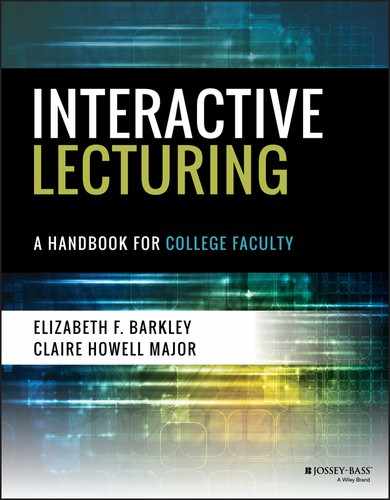ENGAGING LECTURE TIP 15
Signposts
The structure of a lecture is often tacit, but making it more explicit can be beneficial to the listeners who might not otherwise perceive it. Effective lecturers typically describe the overall structure of the lecture at the beginning of a talk, and then along the way they make reference to where they are in terms of the overall structure. These references are usually in the form of words, which may also appear as text or visuals on a presentation slide. This indication of the overall structure and subsequent references to it are what we mean by Signposts.
Signposts are important in lectures for several reasons. Using Signposts can provide students with the cues they need in order to follow the main points. They can provide students with a sense of direction and enable students to anticipate new information, an act that can deepen their learning. They can also help prevent students from losing track of the narrative flow, particularly if they are novice learners in the area, English is not their native language, or if the topic is particularly complex. Signposts are specifically intended to help students stay on track or find the track again if they lose their way. Moreover, they can help students maintain attention by providing them with a sense of how much longer the lecture will be.
There are several key ways to use Signposts: to signal the overarching structure of the presentation, to stress the purpose, to provide background knowledge, to indicate when you have reached key junctures (transitions and lists, points, sub-points, and alerts within each juncture), and to conclude your lecture.
Signal the Overarching Structure
When providing the overarching structure, the type of Signposts you offer are highly dependent on the logical pattern that you have chosen. Consider the examples in Exhibit 6.2.
Stress the Purpose
You may want to provide a signal to help students understand the purpose of the lecture because it is not always readily apparent to them. See the Signposts in Exhibit 6.3.
Provide Background Knowledge
Before you offer new information, you may want to provide a brief summary of what students should know about the subject already. This information could relate to a previous lecture or to background reading students should have done, as shown in Exhibit 6.4.
Indicate Key Junctures
Summarizing what students should already know alerts them to any gaps in their knowledge and also prepares them to receive new information.
Transitions and Lists
When providing signals about transitions or lists, choose Signposts that refer to the initial sign posting. So, for a chronological pattern, for example, you might say, “the next event.”
Main Points
It is useful to choose words that help students distinguish between which information is most important and which is less important. Consider using some of the following signals to draw students' attention to important points as shown in Exhibit 6.5.
Sub-points
In addition to describing the overall structure and providing directions or clues along the way, you can use Signposts to indicate direction within your key points. For example, you might consider using Signposts to introduce an explanation or definition, to introduce an example, or to introduce a digression in which you temporarily move away from the main topic to provide an interesting and relevant aside. Consider Exhibit 6.6.
Alerts
In addition to the just described uses for Signposts, consider creating Signposts to alert students to information they will need to know for upcoming quizzes and exams. Some faculty members like to include these because they believe it enhances attention during note-taking. Others are concerned that if students learn to expect these alerts, they then only pay attention to these particular words. Whether or not to include the following items depends on the context and the students. If you include them, consider the examples in Exhibit 6.7.
Conclude the Lecture
You may end the lecture with a summary of the main points. Consider the signposts in Exhibit 6.8.
In this Tip, we have described Signposts language. If you are using a slide deck, you can include some of this language in your slides. Indeed, we recommend using a title slide or a section header so that these slides look different from your primary content slides.
Example
Key References and Resources
- Gillet, A. (2015). Using English for academic purposes: A guide for students in higher education. Retrieved from www.uefap.com/listen/struct/liststru.htm#emphasis
- University of Leicester. (n.d.). Signposts. Retrieved from www2.le.ac.uk/offices/eltu/presessional-course-information/downloads/sl-materials-week-2/signposts-doc
- University of Southern California, Center for Excellence in Teaching. (n.d.). Preparing and structuring lecture notes. Retrieved from http://cet.usc.edu/resources/teaching_learning/docs/teaching_nuggets_docs/3.1_Preparing_and_Structuring_Lecture_Notes.pdf
